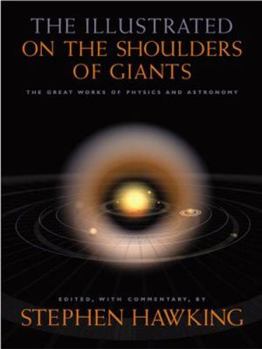Illus on the Shoulders of Gian
Select Format
Select Condition 
Book Overview
World-renowned physicist and bestselling author Stephen Hawking presents a revolutionary look at the momentous discoveries that changed our perception of the world with this first-ever compilation of... This description may be from another edition of this product.
Format:Hardcover
Language:English
ISBN:0762418982
ISBN13:9780762418985
Release Date:October 2004
Publisher:Running Press Book Publishers
Length:256 Pages
Weight:2.15 lbs.
Dimensions:0.8" x 7.6" x 10.1"
Customer Reviews
4 ratings
Physics! History! Math!
Published by Thriftbooks.com User , 18 years ago
It does not get any better than this. Plus the images are stunning.
Read 'Principia...', for no one does it like Newton himself.
Published by Thriftbooks.com User , 21 years ago
Having spent years teaching high school Physics - including the ubiquitous F=ma - I was humbled by the elegance and clarity of Newton's own derivation. There is nothing that I - or authors of textbooks I have seen - can come up with that will explain the three Laws of Motion better than Newton's own presentation. I am surprised that this is not compulsory reading in standard college Physics courses or, more importantly, in teacher training. The `Principia...' are not just of historical interest - they can still be used in education today. It makes, for example, a refreshing change to teach the 2nd Law without using the term `acceleration', focussing on momentum (`movement' in Newton's language) instead.I'm also ashamed to admit it took me so long to notice that since Newton followed Kepler (one of the `giants' to whom Newton's statement refers), Newton derived the Law of Gravitation by combining Kepler's 3rd with his own 2nd and not, as many syllabi would have our students believe, the other way round ["derive Kepler's 3rd law..."]. Better late than never...
The original papers.
Published by Thriftbooks.com User , 22 years ago
What makes this Stephen Hawkin book different is that it collects together in one place the original papers of the great masters, starting with Copernicus, and ending with Einstein. A generation ago, Eric Temple Bell suggested that we begin with the classics when learning math and science. Traditionally, it was thought that modern books based on the classics offered more effective ways of introducing or presenting the material, and as a result only a few students (and teachers) took the trouble of looking at the original classics, the central papers of the great masters. The true landmark papers. All the while, they collected dust on the shelves in the back rooms of libraries. Of the giants in science, five stand out, Copernicus, Galilei, Kepler, Newton, and Einstein. A chapter is reserved to each of the five. Each chapter begins with a lively biography which also serves to place the material in the context of the history of science. This is followed with the original papers themselves in translation. With this book, readers can compare Newton's laws from Principia with the fundamental papers of Einstein. It is collected in one place with commentary. Complaint: The print reproduction of Einstein's papers is not good, and some formulas unfortunately have been truncated in the reproduction. Hopefully that will be fixed in a second edition.
The Great Books of Physics
Published by Thriftbooks.com User , 22 years ago
This is long in coming... A great collection of the greatest works in physics that are all too often never read by modern day scientists. I have always wanted to see a history of physics course or a great books of physics course and this would be the best single volume text. I highly reccomend this for anyone interested in the history of science and the actual thoughts of the great physicists. These are not easy reading, but to see into the minds of these geniuses is enlightening. Covers scientists from Copernicus to Einstein. Truly amazing accomplishments collected into one volume. A great buy!






